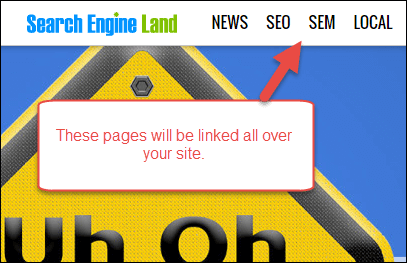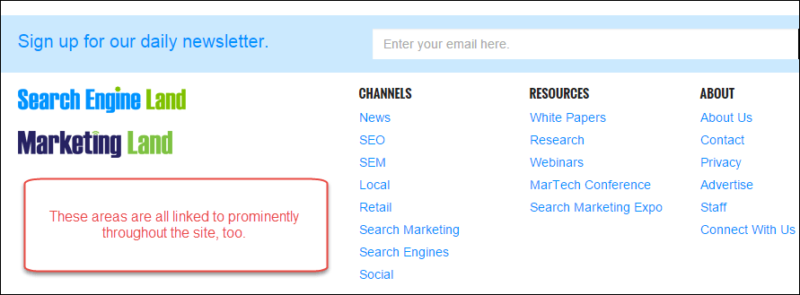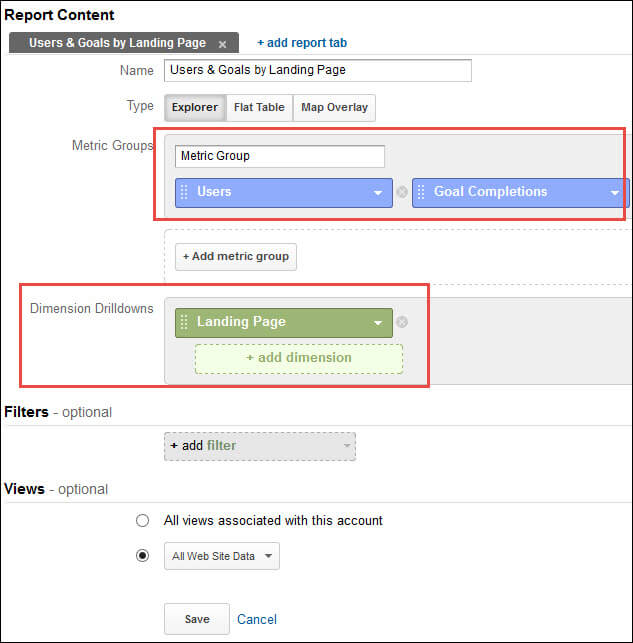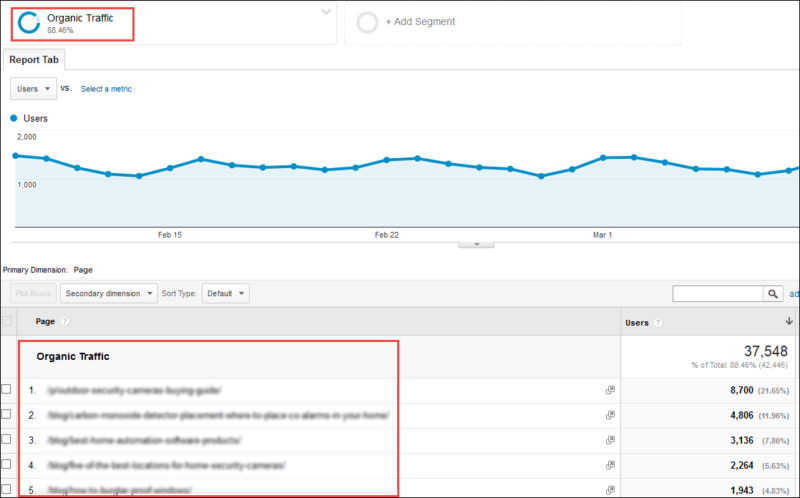Squeezing More Value Out Of Your Most Important SEO Landing Pages
Key landing pages not performing as well as you'd hoped? Check out columnist Tom Demers' helpful guide to getting the most out of your best content.

I recently wrote about how you can dig deeper with an SEO keyword that’s working. Among the tactics mentioned, I included a couple of ways to get more organic traffic for a page that’s already working:
- Flesh out the page that’s ranking for modified versions of the core term.
- Reconsider the ranking page’s title tag.
Of course, updating the title tag and the keyword targeting for a specific page is an early step in most SEO projects, but there are a few tricky problems that site owners frequently get stuck on or don’t spend enough time considering:
- Where do I start? What pages should I actually spend time optimizing?
- What if the page is already driving valuable traffic?
How do you prioritize which pages you should be spending time on? And how do you go about making optimizations to valuable pages without jeopardizing the existing SEO traffic to a page (and making your updates something other than an optimization)?
In this article, I’ll walk through a number of steps and tools that site owners can use to identify areas where they should spend time in updating pages, to better understand what’s at risk in updating a page, and to get more valuable traffic out of key SEO pages.
Know Where You’re At
The first step is to identify the pages you want to work on. Here are a few ways to think about where to spend your time:
- Zero to One Opportunities. Where are the pages that have potential but currently aren’t doing anything for you? These won’t show up at the top of your analytics and ranking reports (since they’re not driving traffic), so you need to look in other places for them. What are the main pages in your site’s navigation (linked to from your site’s header or featured in your side bar)? These are being linked to prominently, but they may need to be optimized. What are your useful, content-rich pages that provide lots of answers for your customers (like community Q&A content, in-depth tutorial content, or quality blog content that hasn’t gotten traction)? These may not be featured prominently, may not have gotten a good promotion push, and may have been created without search traffic in mind, and thus may be great optimization candidates.
- Low-Hanging Fruit. What’s the content that’s ranking 5–10 or at the top of the second page in search results? It might not be prominently linked to in your site’s architecture and internal linking, and it might benefit from a few tweaks to better target terms that could draw more traffic.
- Top Performers. Your best performing pages may be able to work even harder for you. Again, make sure not to damage the traction you’ve gotten.
So how do you identify all these different juicy opportunities? Glad you asked!
Zero To One Opportunities
If you have a site that’s authoritative and has a strong brand that has neglected SEO, this will likely represent your biggest opportunity. If you have a site that’s not getting links or press mentions, and you’ve spent hours tweaking title tags without much in the way of returns, you’re in the wrong section (and maybe the wrong article altogether: try starting with a comprehensive content creation and promotion strategy).
However, if you have domain authority to spare and lots of pages that are important for visitors to your site, but you haven’t been driving the kind of SEO traffic you’d like, you can start by looking at the main navigation elements on your site.
Here are examples from Search Engine Land’s top navigation:
Footer:
And sidebar:
There are lots of highly linked-to pages here. Not surprisingly, Search Engine Land has taken SEO into consideration on a lot of these pages, but there’s a good chance that your site (or your client’s) was mapped out with minimal (or no) consideration for SEO impact. This means that these highly linked-to pages are possible optimization candidates.
We’ll walk through how to look at these later in the post, but if these are pages that have title tags like “About” (or all share the same title tag), and if they don’t have meta descriptions or aren’t tuned for SEO, add their URLs to your list of optimization candidates.
(A handy way to parse the list of links from the HTML is to use BuzzStream’s free tool.)
Low-Hanging Fruit
This is a pretty straightforward process: simply use your search analytics report or run your own site through SEMrush, and look for high impression/high estimated search terms where you’re ranking decently well (5–10 on page one of search results, or top of the second page). Add these to your list of URLs to optimize.
These pages are ranking, and you know the terms have potential (either because of estimated search data or the impression data you’re getting from your own search analytics report), so with some tweaks, you might be able to improve rankings for key terms.
If you’re looking for a more in-depth look at this process, Nick Eubanks’ (paid) Master Keyword Research Course has a great section on identifying low-hanging keyword fruit.
Top Performers
This part is pretty straightforward, too. Look at your analytics reports for heavily trafficked pages, and look at your Google search analytics report for both high-traffic and high-impression pages.
Within Google Analytics, you simply start with a custom report:
For Metrics Group, you can add Users > Users and Goal Conversions > Goal Completions (you might customize this based on your site’s goals, whether you have specific values configured in GA, etc.). For dimensions, it’s Behavior > Landing Page.
Next, you can segment for organic traffic and see the pages that are driving traffic:
To get to your search analytics data, simply log in to your Google Search Console (formerly Webmaster Tools) account, look at the left navigation, click through Search Traffic > Search Analytics, and click Pages to see your data:
Grab the URLs you didn’t find in your analytics report (the impression data can be particularly useful for additional discovery, as you’ll see the URLs where people are seeing your listing but not clicking through), and you have some additional URLs.
Now you should have gathered a large number of different types of URLs that are good optimization candidates. It’s time to start actually optimizing your site for these terms. Let’s walk through 10 things you can do to get more out of your most important pages.
1. Determine What’s Already Ranking & Driving Traffic
Before you start to update the pages you’ve identified as opportunities, you need to understand what not to eliminate from your page’s title and content. As I mentioned above, one oft-overlooked component of optimizing pages is to first see what the page is already ranking for. This will tell you two things:
- Where are the opportunities to make tweaks and help improve rankings on specific terms?
- What is the page currently ranking for that changes could negatively impact?
Depending on what tools you have enabled and your level of access to different data, there are two primary places to look for this information:
SEMrush (Or Other Competitive Keyword Tools). You can enter a keyword into these tools and get a sense for what terms a page is ranking for (I use SEMrush, but other competitive keyword tools also offer this data). Let’s look at a few terms that a page about using bouncy houses safely is ranking for:
Google Search Console Search Analytics Report. As outlined above, we can also look at the Search Console search analytics report to get similar information. First, simply input a filter for the URL of the page you’re updating by clicking the “no filter” text under Pages and adding your filter:
Be sure to highlight Queries and check clicks, impressions and position to see what’s getting impressions and where the page is ranking for those terms:
This particular page isn’t ranking great for anything, so I’m free to update the page and try to improve rankings on some of the terms that are showing up in the second page of search results. But if there were terms that were driving a lot of traffic here, I’d be able to factor that into my edits to the page (and make sure I didn’t remove a valuable modifier that’s driving a lot of traffic).
2. Run Your URL Through The Keyword Tool
Now that you understand where your URL is currently ranking, you can start to look for new opportunities.
The terms the URL is currently ranking for represent good expansion opportunities, but what about terms you (or your client/the original author of the page) weren’t aware of? Google’s Keyword Planner can give you some quick ideas for terms the page may not be targeting:
3. Get Google Suggest Data For The Primary Topic Of The Page
Similarly, using Google Suggest (by typing a term into Google and seeing the suggested results) and tools like Ubersuggest, you’ll get a long list of commonly searched-for modifiers around the main topic of your page to think about including in your optimization process. In this case, I’d enter terms like bouncy house, bouncy castle, jumpy house, and so on.
4. Update Your Page’s Title Tag, Meta Description & Alt Attributes
After looking at the rankings for your page and understanding some of the other things folks search for around your topic, you should be able to craft a better title tag (that is clickable and potentially includes a key modifier that had been ignored previously) and a more compelling meta description (that better speaks to the searchers who are finding your listing). You’re also aware of different terms you can include in alt attributes on your page to describe your images (or in many cases, you can start to include alt attributes).
Writing great title tags is particularly valuable, and that’s a topic for its own lengthy post, but luckily, there are a number of useful resources on the topic:
- Moz’s visual guide to on-page SEO and their overview of what a title tag is (if you’re unfamiliar)
- Hobo Web’s title tag guide
- Backlinko’s guide to on-page SEO
- A great post by Siege Media on rethinking your title tags and improving CTR
5. Flesh Out The Page With Additional Content
Now that you have some information about additional terms folks are searching for, you can use that to flesh out the page. The most searched-for modifiers could be great sub-sections of an article or additional sections of a product or sales page. You could also scan the existing content for opportunities to (naturally) include some of the modifiers the page had omitted in the body content of the page.
6. Add Different Content Types If Applicable
You don’t just need to add text to your page, either. You can flesh out an existing page with video content, a slide deck or a data visualization, for example. A PowerPoint or a video has the added benefit of giving you another place where you can be found for these key terms (within YouTube search or on SlideShare).
7. Create A Specific, Customized Offer
There’s more to SEO than just ranking better and getting more traffic. You can get more value out of your most important SEO pages by having the traffic coming to those pages convert better.
Look at the pages that drive the most traffic. Can you customize the offer on those pages with a specific offer or content upgrade?
The first few steps have given you some insight into the actual searches people are using to find your page. You can use that data to help create a highly customized offer.
Are folks typing in “buy” and other transaction-oriented modifiers to find your page? You might want to give them a special deal if they purchase now. Are they using terms more along the lines of “compare” or “reviews?” You might want to offer a free buying guide or a third-party report comparing the product type your page is targeting.
By using a specific offer tailored to the way people are finding your page, you can help convert more of the SEO traffic arriving at your most valuable pages. (Note: Be sure to understand the other channels people are reaching your page from — if the page drives traffic from referrals, bookmarks, etc., that should help inform your offer strategy on that page.)
8. Layer Outreach On Top Of That Page
If you have a key page that’s close to ranking well for key terms, you can give it a push with some link outreach. If the page is a meaty resource, you might be able to engage in some old-school link prospecting and outreach. If you’re working on a page that isn’t likely to be linked to as is, think about adding useful content that you can conduct outreach for, and/or incorporate other resources and let them know you’ve highlighted them on the page.
9. Do Some Social Promotion For The Page
If the page is an article that is likely to be shared socially and is close to ranking for some valuable terms, identify the social network that’s the best fit and consider doing some social promotion (potentially even some targeted paid social promotion for your content) to get better distribution (and frequently more links) for that page. And of course, if the content is high-quality and share-worthy, make sure the page is easy to share.
10. Link To The Page Internally With Different, Useful Anchors
Good old-fashioned internal linking and information architecture can help you get more SEO value from important pages, too. By highlighting pages that are very close to ranking (and working to link to key pages with varied anchor text that includes some of the key modifiers you’ve unearthed through the research in previous steps), you’ll help spread link equity (and internal traffic) to those pages, which should give them a nice rankings boost.
For a more in-depth look at internal linking, check out my SEO basics guide on the WordStream blog or my business partner Ken Lyons’s internal linking tips.
Final Thoughts
If you’re an SEO-savvy company or agency, the main takeaway here is that you need to understand the current positioning for a page so that you avoid taking one step forward and two steps back.
If you’re a small business or individual blogger, you don’t need to work on every one of these items for every page on your site. Identify the 5–25 most valuable pages, make sure you don’t harm rankings on key terms, and incorporate as many relevant tactics to help improve search traffic as you can for those pages. Do this, and you’ll start to generate more relevant, valuable traffic to your site.
Contributing authors are invited to create content for Search Engine Land and are chosen for their expertise and contribution to the search community. Our contributors work under the oversight of the editorial staff and contributions are checked for quality and relevance to our readers. The opinions they express are their own.
Related stories









